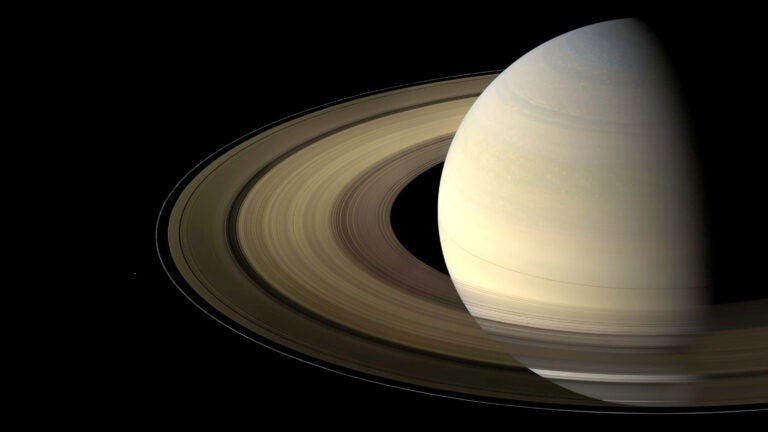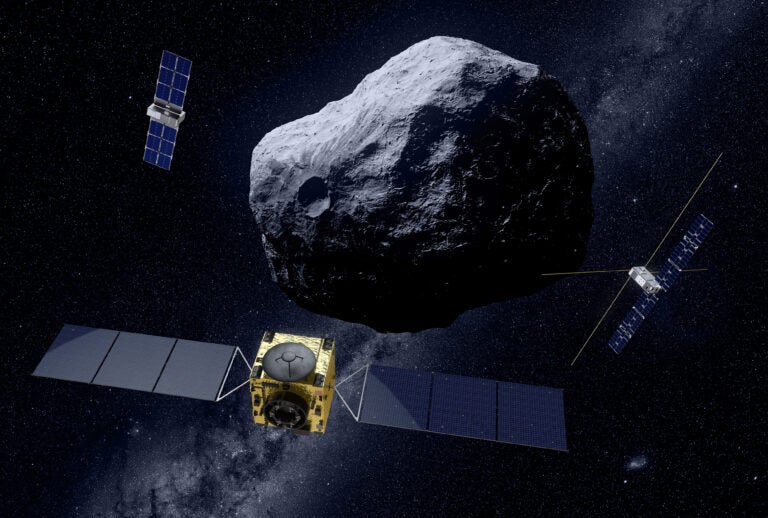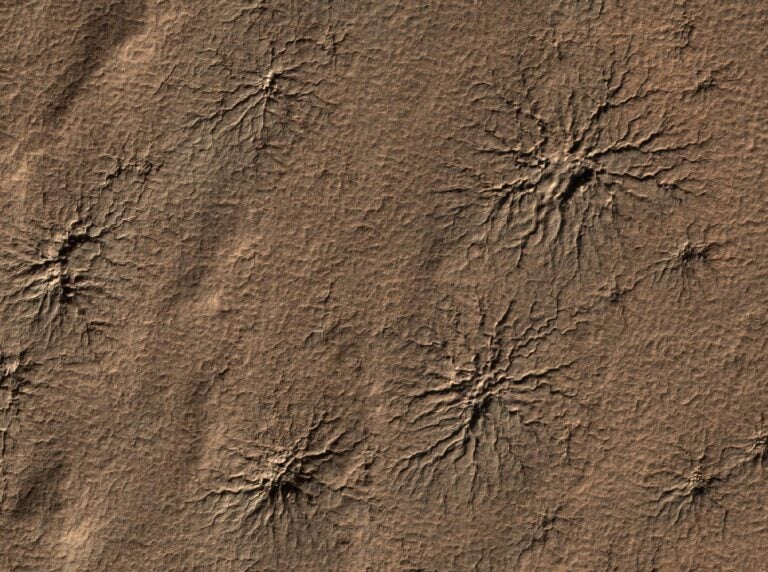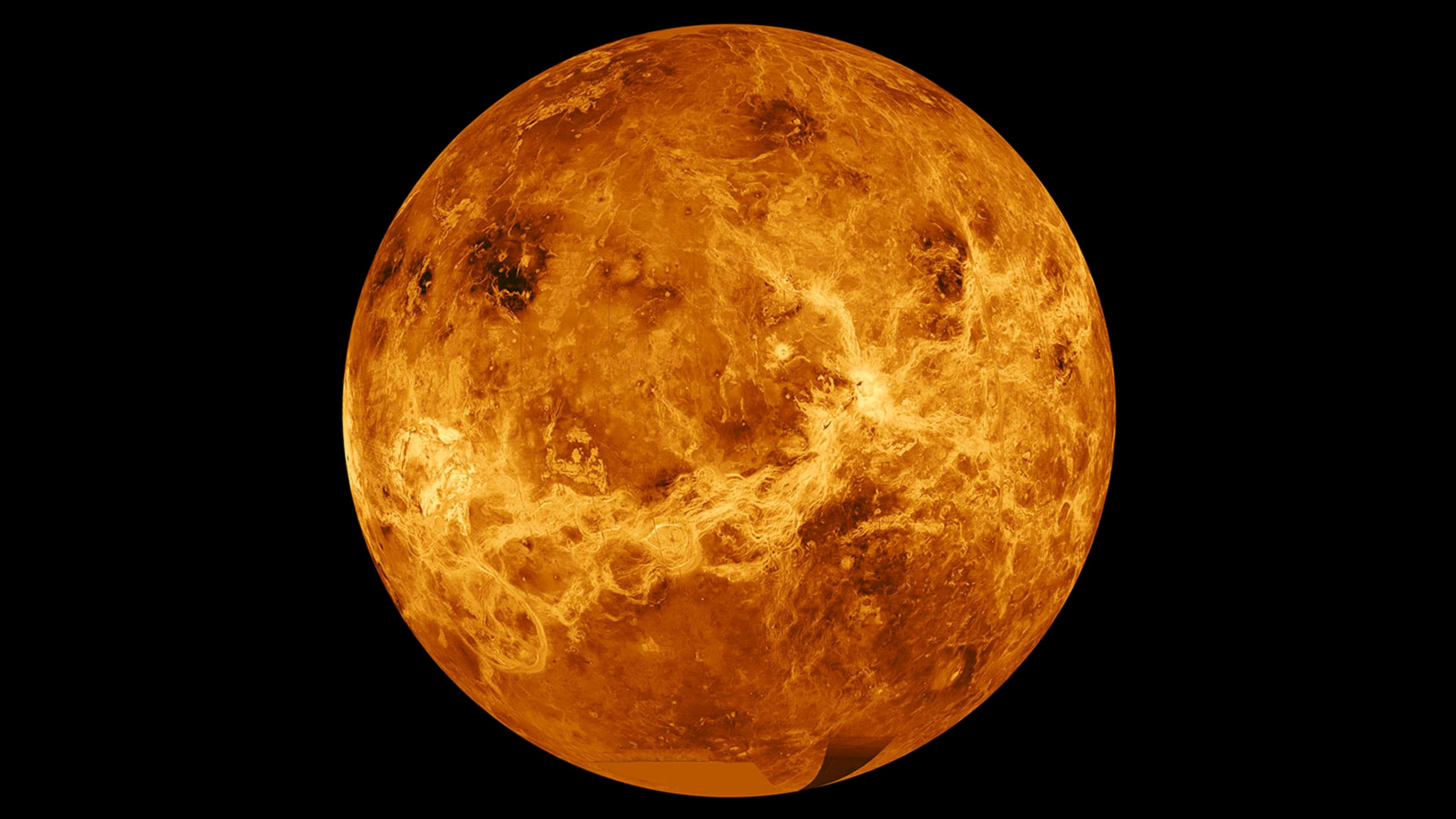
If the exploration of the planets has taught us one thing, it is that Murphy’s law — “anything that can go wrong will go wrong” — is alive and well throughout the solar system. But one planet in particular exhibits more than its share of quirks: Venus.
It’s no wonder. Venus is a tough place to study, let alone land on. The planet’s toxic environment is seasoned with sulfuric acid and pressurized at the surface to 90 times the crush at Earth’s sea level, or roughly equal to that of an ocean depth of 3,000 feet (900 meters). Temperatures soar to 900 degrees Fahrenheit (482 degrees Celsius). And every four days, an atmospheric tsunami sends a front of hurricane-force winds around the globe.
Despite those obvious challenges, the spacecraft that have dared to land on Venus’ brutal plains have revealed a planet much more complex and fascinating. Although Venus is closer to the Sun than Earth by a third, that alone cannot explain the dramatic differences between our two worlds. And Venus’ massive ocean of air and extraordinary environment are critical to our understanding of issues like climate change and extreme weather on Earth.
Despite Murphy’s law — or perhaps because of it — scientists are getting closer to understanding what makes Earth’s sibling planet tick.
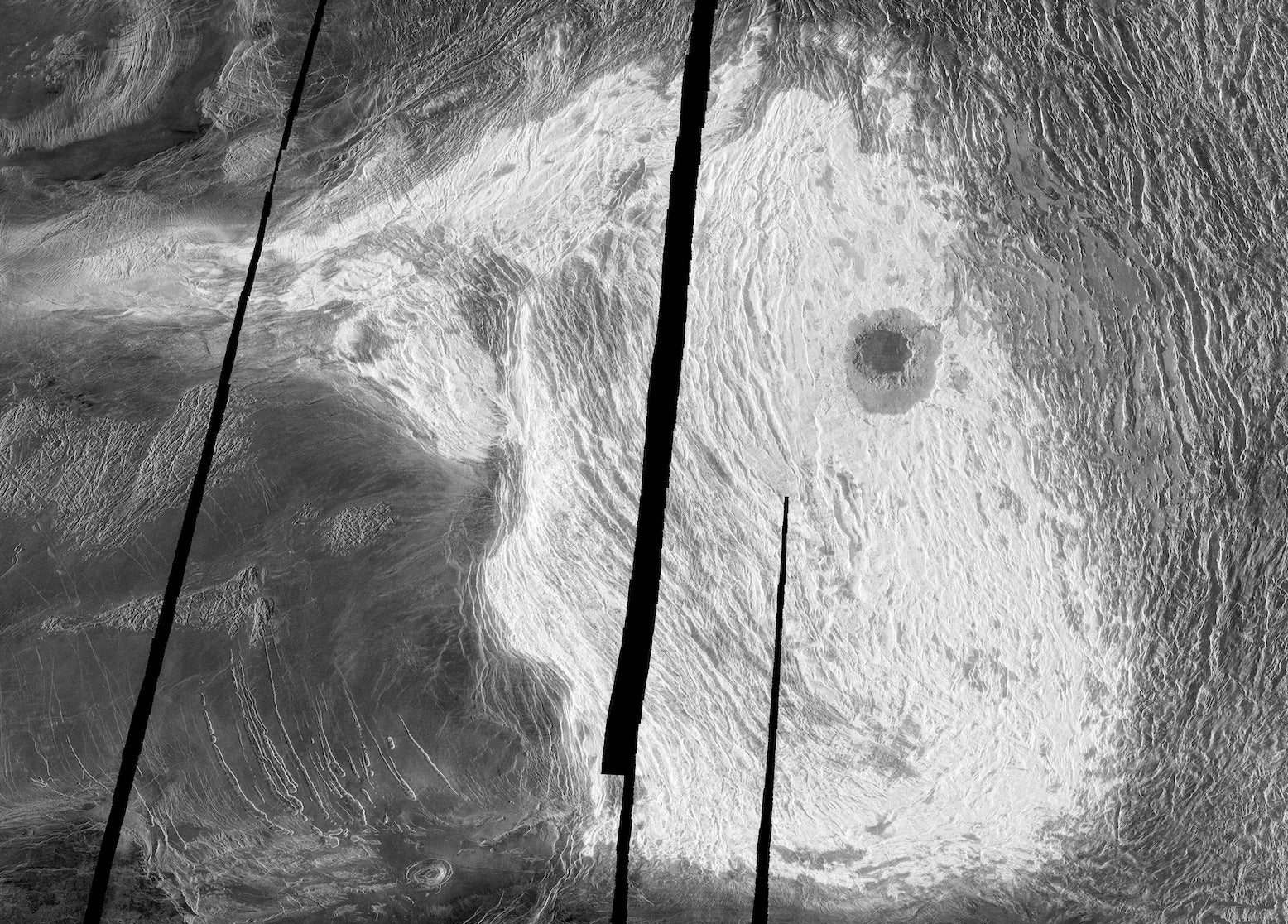
Water, water everywhere?
The first probe to fly by Venus was Mariner 2, in 1962. The scorching atmospheric temperatures it found confirmed that the planet had been the victim of a runaway greenhouse effect. But in 1978, NASA’s Pioneer Venus Multiprobe mission found evidence for something that seemed unbelievable: The desiccated, desolate planet may once have had oceans washing across its ancient face.
The groundbreaking discovery was unplanned. As the large probe deployed by the main spacecraft descended through the venusian atmosphere, a cloud droplet clogged the intake of an instrument. Although the droplet prevented many readings of the environment over the rest of the descent, researchers were able to carefully chart the makeup of the droplet itself.
They found it was rich with deuterium — an isotope of hydrogen with an extra neutron. Deuterium is somewhat rare, with about 1 for every 6,500 normal hydrogen atoms on Earth. That ratio tells scientists about the history of that hydrogen. On Venus, deuterium is about 100 times more prevalent than on Earth. This indicates to some researchers that Venus must have once had vastly more hydrogen — most likely in the form of water, and oceans of it. As solar radiation blasted Venus over eons, the lighter, regular hydrogen drifted off into space, leaving behind an overabundance of deuterium.
Venus and Earth arose near each other within the Sun’s formative solar nebula. The two worlds must have come from roughly the same building blocks. As astrobiologist David Grinspoon of the Planetary Science Institute in Tucson, Arizona, wrote in the book Alien Seas (Springer, 2013), “Unless some tremendously efficient process dried Venus out completely, it must have started with more water, perhaps even an Earth’s ocean’s worth of water — perhaps 10 times this much.”
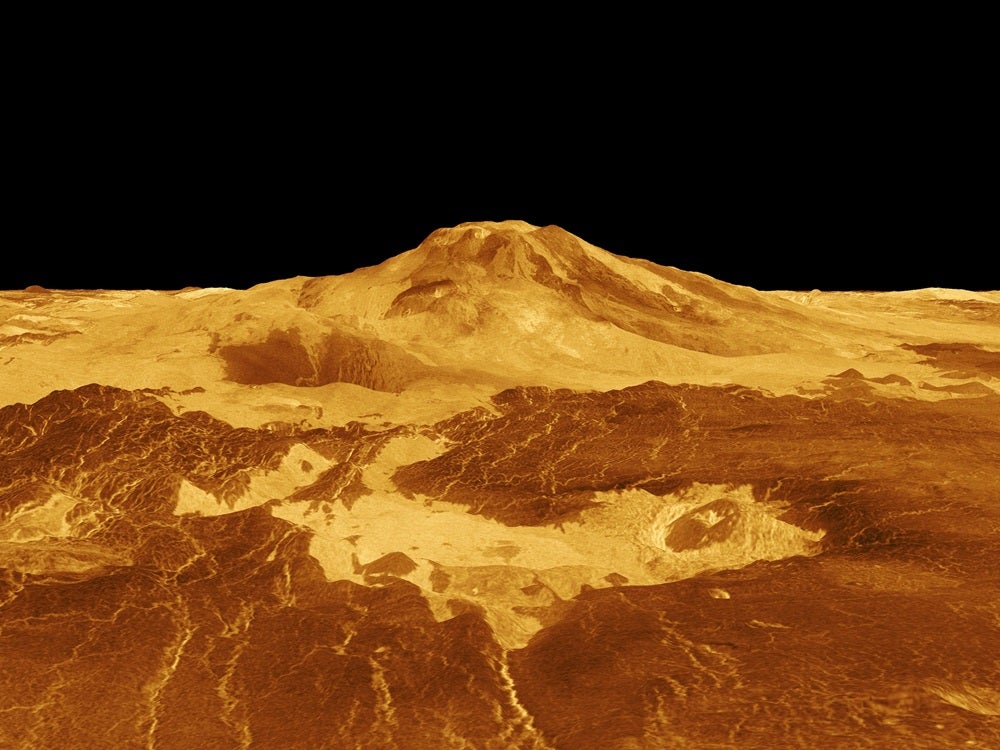
Additional evidence for oceans came from the Soviet Venera 8 lander, which touched down on Navka Planitia in 1972. The spacecraft carried a gamma-ray spectrometer that took measurements of the air during descent, along with two precious-mineral readings from the surface. The instrument detected potassium, uranium, and thorium — a cocktail of elements also found in granite. Infrared imagery from subsequent missions has yielded hints of granite mountains, as well. Granite forms in the presence of water, making this a possible sign of long-gone ancient seas in a more temperate era.
Over the rest of the decade and into the mid-1980s, the Soviet Union’s Space Research Institute sent an armada of landers and orbiters to further explore this possibility. Many of these probes saw Murphy’s law raise its fickle head.
The Venera 9 and 10 landers incorporated design improvements over earlier spacecraft, but in both cases, their lens caps jammed on one camera. (Both carried a rear and front camera system, so they were still able to transmit the first dramatic images from the surface of another planet.) Engineers crafted new seals for the cameras on Venera 11 and 12. The seals worked too well: All the camera covers jammed on, so the twin landers returned no images. It turned out that the air pressure outside was higher than that inside the sealed cameras, so the pressure difference simply held the caps in place. Later designs had better venting, allowing for spectacular full-color 360° vistas.
But even properly working lens caps caused mishaps. After landing on an enchanting landscape of broken fine-grained, layered stone, Venera 14’s lens caps successfully ejected. The rear panoramic camera saw its cap resting atop plates of interlocking rock. But in the front view, the cap seemed to have vanished. Then shocked flight engineers spotted it, lying directly beneath the spring-loaded arm that was to probe the soil’s firmness. With no ability to rearticulate the arm, Venera 14 suffered the indignity of traversing the inner solar system only to measure its own lens cap!
Sometimes humans contributed some bad luck of their own. During the design of the Venera 13 and 14 color cameras, Soviet researchers developed advanced paints that could retain their color even in the 900 F (482 C) heat. These would be placed in the camera’s field of view to calibrate the color images. In those days, the Soviet system was divided into two departments: the engineers who researched and designed the mission, and a different ministry that fabricated the hardware. The latter’s industrial plants had “suggestion boxes” where workers were encouraged to make suggestions about ongoing projects. One creative factory worker noted that the ministry was paying incredible amounts for exotic paint chips when cheaper paint was readily available. Commercial paint was substituted and the worker was rewarded for their contribution. Sadly — as the engineers predicted — the paint immediately lost its color in the furnacelike venusian conditions.
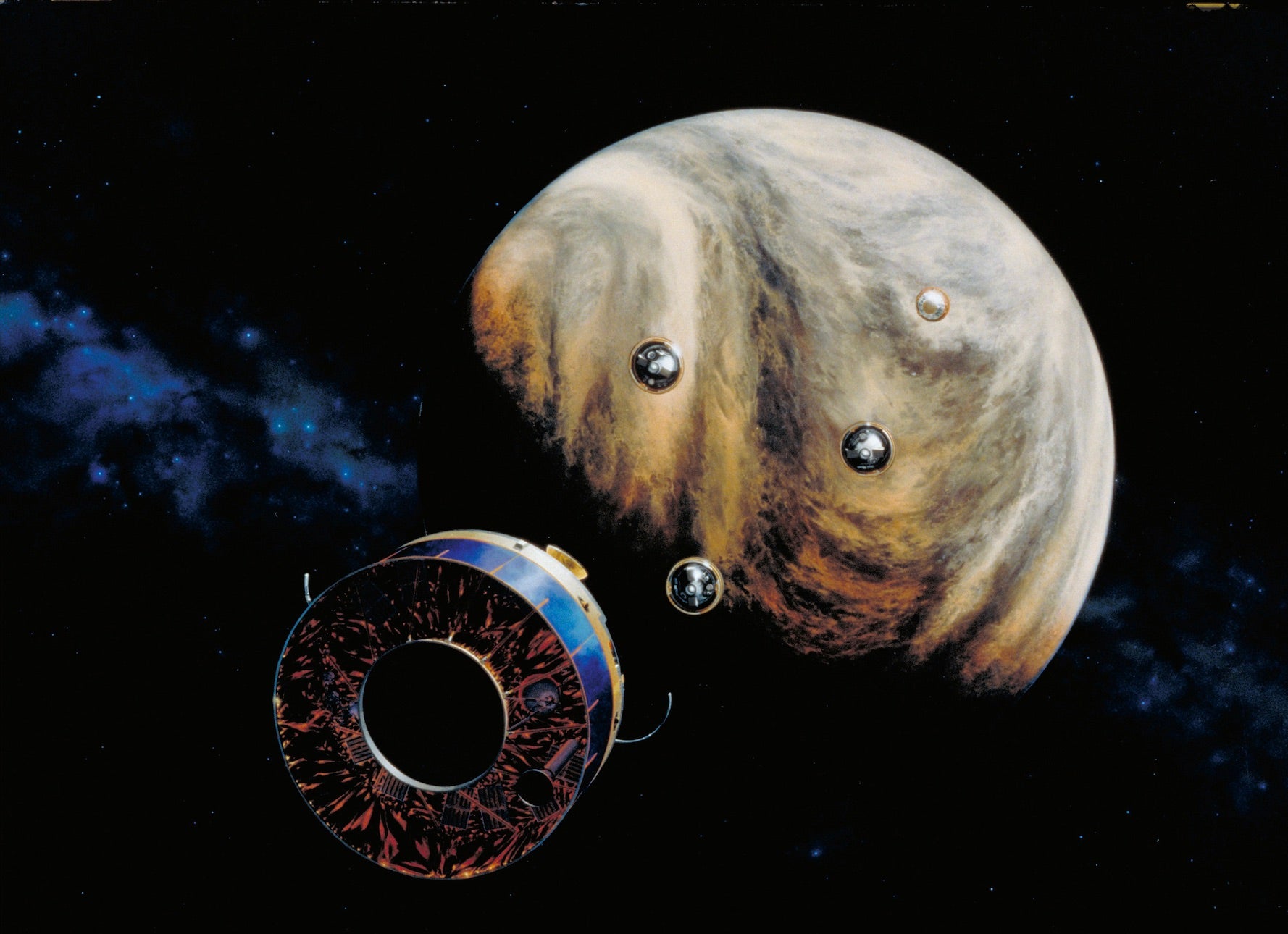
An atmospheric anomaly
Perhaps the most intriguing instances of Murphy’s law befell both U.S. and Soviet probes. NASA researchers called it the Pioneer Venus 12.5-kilometer anomaly: a strange occurrence that afflicted the four probes in the Pioneer Venus
Multiprobe armada as they simultaneously descended through Venus’ complex atmosphere. At an altitude of about 7.5 miles (12.5 km), below the planet’s known cloud decks, a power spike surged through all four probes, even though they were thousands of miles from each other, some in daylight and some in regions experiencing night. This resulted in bizarre readings of temperature and pressure. Many instruments failed completely, losing valuable data. What was going on within those battery-acid clouds?
Some engineers say the power spikes were due to the hardware design of the Pioneer probes themselves. A 1993 NASA report found that “[a]ll anomalous events are now explained” by a failure of insulation material. Protective Kapton tape had been tested in chambers simulating Venus conditions and deemed adequate for the wiring on the probes’ external sensors. But technicians decided to reinforce the external connections by using Kynar, a type of shrink tubing not tested in the same manner as the Kapton had been. When this tubing reached 620 F (327 C), it could have released corrosive hydrogen fluoride vapors that dissolved the Kapton insulation, shorting out the connections.
However, a hardware failure common to the Pioneer probes doesn’t explain all aspects of the phenomenon. “What’s puzzling is that different spacecraft had the same anomalies,” says Grinspoon. Soviet probes Venera 11, 12, 13, and 14 all experienced similar power spikes at about the same altitude. And years later, the Vega 1 Venus lander may have prematurely triggered its landing sequence when its sensors indicated that it had landed — some 11 miles (18 km) above the surface. Vega 1 dutifully drilled and sampled, but there were no rocks up there to test. (Strangely, the sister craft, Vega 2, had no ill effects at similar altitudes.) In 1995, three Washington University geochemists proposed a different possibility for the Pioneer Venus anomaly: metallic fog in the highlands. Evidence for this weather phenomenon came from radar imaging of the planet, which revealed a strange pattern of brightening on high ground. In radar imagery, bright reflections usually mean a rough surface, but on Venus this shimmering veneer blankets everything from craggy mountains to high plateaus.
To explain this, the team noted that on Venus, as on Earth, temperatures drop with altitude. Low-lying plains on Venus simmer at a blistering 872 F (467 C), while the radiant higher elevations cool down to a lovely 728 F (387 C). And at Venus’ drastic pressures, certain metals that can exist as vapor in the lowlands could migrate to higher terrain, condense as they cool, and even accumulate on the ground as “snow.”
A variety of metals could be involved, including chlorine, fluorine, and sulfur. Other intriguing candidates include lead sulfide, bismuth, the chromelike metal tellurium, and iron pyrite (fool’s gold). These metals also appear to condense at about the same altitude as the Pioneer Venus anomaly. If they condensed on the surfaces of all these probes, they could have triggered a host of breakdowns and temporary electrical failures — and would certainly qualify as another arrow in Murphy’s quiver.

Tale of two worlds
Fortunately, answers to this and other mysteries may be at hand in the coming years. Researchers and space agencies are preparing a new wave of Venus missions slated for launch in the early 2030s. These include the European Space Agency’s EnVision orbiter; NASA’s VERITAS orbiter; and NASA’s DAVINCI mission, which will consist of an orbiter and an atmospheric probe — the first craft to venture into the planet’s clouds since the USSR’s pair of Vega balloons in 1985. (VERITAS is an acronym for Venus Emissivity, Radio science, InSAR, Topography, And Spectroscopy; InSAR, or interferometric synthetic aperture radar, is a radar technique for mapping terrain. DAVINCI stands for Deep Atmosphere Venus Investigation of Noble gases, Chemistry, and Imaging.)
To make up for its capricious ways, Venus has bequeathed to humanity information critical for our own good. Scientists and policymakers have come to realize that Venus is an important mirror that can help us understand some deep truths about our own planet on issues ranging from global warming to the depletion of the ozone layer. It serves as a climate laboratory, an extreme-weather observatory, and a cautionary tale — a bleak example of what could happen to our fragile world. Through its inhospitality, Venus may help us to better manage Earth’s resources and environment, and to avoid changing this temperate world into one more like that of our twin next door. Though Murphy’s law may spare no spacecraft, it doesn’t have to apply to our own planet.

How Venus saved our skin
In the early 1970s, scientists were seeking to understand the dominance of carbon dioxide in the venusian atmosphere. Through this work, planetary scientists like Harvard University’s Michael McElroy became aware of the importance of catalytic reactions involving chemicals like chlorine in Venus’ atmosphere, which reacts with and breaks down ozone. In April 1974, McElroy co-authored a paper warning that the chlorine emitted in the rocket exhaust of NASA’s upcoming space shuttle could threaten Earth’s ozone layer, which shields us from harmful ultraviolet radiation.
Just two months later, a pair of chemists at the University of California, Irvine, Mario Molina and Sherwood Rowland, independently identified a much bigger source of chlorine: chlorofluorocarbons (CFCs), which were widely used in industry as refrigerants, insecticides, spray can propellant, and more. Their work was published in Nature.
At ground level, CFCs are stable and nontoxic. But as they drift higher into Earth’s atmosphere, the Sun’s ultraviolet rays break them down and the resulting chlorine destroys ozone through catalytic reactions — the same process that McElroy’s group had identified on Venus. Using atmospheric-mixing models that McElroy and his colleagues had developed for Venus, Molina and Rowland concluded that these chemicals could last for up to 150 years.
We had unknowingly set the stage for turning Earth into a hot zone of skin cancer and damaged crops. The result was the Antarctic ozone hole, which was discovered by British researchers in 1985.
The good news is that governments and industry took action to reduce the use of CFCs worldwide and the ozone hole is now shrinking. A January 2023 report from the U.N. found Antarctic ozone levels are expected to recover to 1980 levels by 2066.






